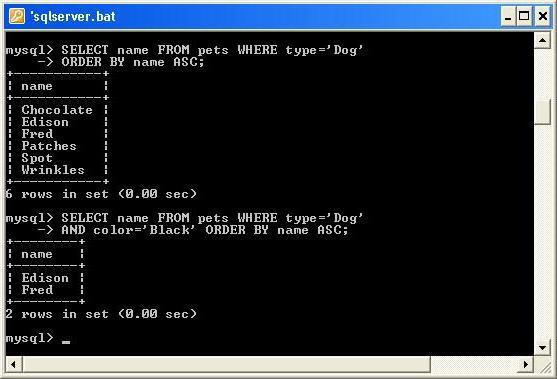
MySQL, like any other relational systemdatabase management, has in its structure a select statement SELECT. This is not surprising, because databases store information in themselves primarily in order to extract it when necessary. Operator MySQL select from SELECT allows you to do this in a variety of ways, by providing a large set of tools.
MySQL is implemented for both Windows and Linux. To install MySQL Ubuntu, it is enough to execute two commands in the terminal of this OS:
- sudo apt-get install mysql-server.
- sudo apt-get install mysql-client.
For MySQL Windows, it is enough to download the corresponding installation packages from the official "DBMS" site and run them.
The complete structure in MySQL select from SELECT statement looks like this:
1. SELECT - the names of the columns (fields).
2. FROM - table names.
3. WHERE is the condition for sampling.
Note that although the syntaxThe SQL language is not case-sensitive; it's a good idea to write operators and reserved keywords (FROM, WHERE, etc.) in capital letters, and the names of the tables and their columns are small. The simplest example of using an operator MySQL select from SELECT is shown in the figure below.

An asterisk after the word SELECT is an analogkeyword ALL and means that you must select all columns from the specified table. If you are interested in only some fields of the table, they should be indicated in the appropriate place through a comma. The same applies to the names of the tables - if there are more than one, enter them all separated by commas.
Obviously, you could not help but notice that inThe previous example does not have the keyword WHERE - this is because in this case we do not need it. This operator is not mandatory, and there are many such optional operators in SELECT, but they are a little later. If you add after the WHERE table name and any condition, for example type = 'dog', then in the resultant selection you get only one row with the pet named Edison. The figure below shows an example. Do not pay attention to the ORDER BY clause, it does not play any role, and it will be discussed a little later.

It should be noted that after WHERE it is also possiblewrite several conditions, but not through a comma. For this purpose, you must use keywords such as AND or OR. It all depends on how your conditions should be respected. If you are interested in a result that satisfies all the conditions you specify, then there must be an AND between them, and if the result should satisfy at least one of them, then use OR.
We mentioned that in addition to WHERE in the SELECT statementThere are many other keywords with which you can manipulate the resulting selection as required in a particular situation. One such "key" is ORDER BY. It allows you to sort the results of a sample by a specific field, either in ascending or descending order. To do this, you just need to specify the name of the column after it, by the values of which you need to sort the data. It is important to observe several conditions: first - the name specified in the ORDER BY clause must be present in the SELECT itself; The second - ORDER BY must be placed at the very end of the request.

By default, sorting is performed in ascending order (ASC), but if you want to sort the result in descending order, write the DESC keyword after the field name instead of ASC.
We examined the basic, but not all, of the MySQL select from. SELECT, in addition to the above, has a lot of other features that allow you to extract data from the database flexibly and efficiently.
